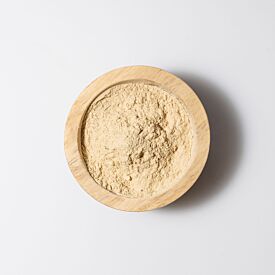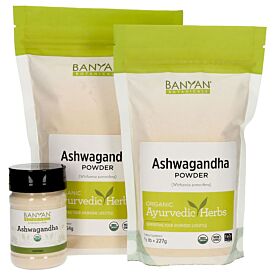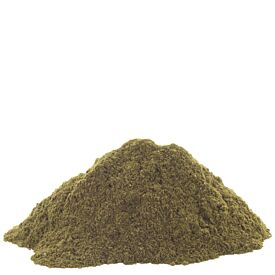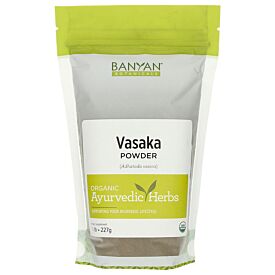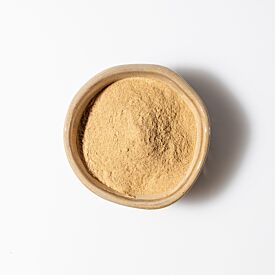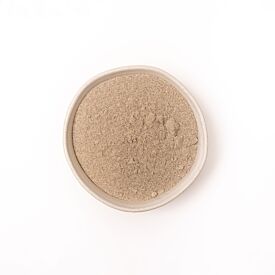The Benefits of Chyavanprash
Chyavanprash, also called chyawanprash, is a delicious nutritive jam that has been used in Ayurveda for thousands of years, offering a wide range of benefits. It is revered for its nourishing and rejuvenating properties and well known for its capacity to strengthen and bolster overall health.
Thanks to its sweet taste and lickable, spoon-friendly texture, chyavanprash is a favorite with children. It’s also greatly supportive for the elderly and anyone needing an extra foundation of nourishment.
In this Article:
- What Is Chyavanprash?
- Chyavanprash Benefits and Uses
- How to Take Chyavanprash
- Modern Research on Chyavanprash and Amalaki
- Is Chyavanprash Safe?
- About Banyan’s Chyavanprash
What Is Chyavanprash?
In Sanskrit, the word “prash” refers to a specially prepared food.
It is said that two ancient sages of Ayurveda concocted this particular formula to restore youth to the elderly sage, Chyawan—thus the name, “chyawanprash.”1
The transliteration from Sanskrit to English has resulted in a variety of spelling variations, including: chyavanprash, chyawanprash, chyavanaprasam, and chyavanaprjasha.2 Banyan Botanicals offers this preparation as Chyavanprash.
Ayurvedic jams are often used as anupans (carriers) for other herbs, but they can also be used on their own and frequently are—especially as rejuvenatives and aphrodisiacs.3
Chyavanprash Ingredients
Chyavanprash is made with a base of amalaki fruits (Emblica officinalis) and typically contains a number of other herbs, ghee, sesame oil, cane sugar, and honey.
The honey, ghee, and sesame oil serve as yogavahis (catalytic agents) to carry the herbs deep into the tissues, while the sugar is considered a samvahaka dravya (preservative substance) which helps to safeguard the clinical efficacy of the main ingredient, in this case amalaki.4
Amalaki, also known as amla or amla powder, is renowned for its rich antioxidant content and is generally known to contain vitamin C. Some even say that amalaki has one of the highest known concentrations of vitamin C in the plant kingdom.5
More importantly, the vitamin C frequently contained in the amalaki fruit is stabilized by the presence of tannins, which help to preserve the vitamin content, even through processing.6 This is particularly relevant in a preparation such as chyavanprash, which requires extensive cooking.
While the first known source of the “recipe” for chyavanprash is found in the Charaka Samhita, an ancient Ayurvedic text, the jam is also described in several other respected Ayurvedic texts, often with some alteration to the “original” formula.7
In fact, there is an extensive history of variation in chyavanprash preparations and appropriate amendments are therefore considered acceptable.8 This being the case, modern concerns for sustainability and availability of herbs have resulted in a wealth of chyavanprash varieties, all essentially sharing the same core benefits.9
Banyan’s Chyavanprash is based on a traditional Ayurvedic recipe and influenced by the specific herbs that we’re able to ensure are organic, sustainable, and of the highest quality.
Chyavanprash Benefits and Uses
This nutritive herbal jam, with its rich source of antioxidants and vitamin C, has long been a trusted source of strength and rejuvenation in the tradition of Ayurveda. It tones and nourishes the entire body, providing energy, vitality, and bolstered immunity.
Chyawanprash also supports the body in the following ways:
Supports immune function. Rich in vitamin C and other nutrients, chyavanprash strengthens the body’s natural defenses and promotes proper immune function. It supports the body’s natural ability to produce hemoglobin and white blood cells.10
Promotes strength and energy. Thanks to its building and nourishing nature, chyavanprash lends strength, energy, and vitality to the entire body.11 It also helps to build toned and healthy muscle mass.
Rejuvenates the tissues. Considered a rasayana, or rejuvenating formula, it tones and nourishes the tissues of the entire body, preserving youthfulness and promoting systemic health and well-being.12
Preserves youthfulness. By nourishing and protecting ojas, the essence of vitality, chyavanprash is said to support healthy aging and to promote beauty, intelligence, and memory.13
Supports the heart and respiratory system. Chyavanprash is particularly good for the lungs because it nourishes the mucous membranes and helps to keep the respiratory passages clean and clear. It is also considered a tonic for the heart.14
Fortifies the reproductive system. It replenishes the reproductive system and vital sexual energy. In more general terms, chyavanprash supports fertility, healthy libido, and builds overall sexual strength.15
Supports healthy digestion and elimination. It stimulates a healthy digestive fire and tones the GI tract, supporting proper digestion, elimination, and metabolism.16
Chyavanprash in Ayurveda
From an Ayurvedic perspective, chyavanprash is considered one of the best family tonics—suitable for most ages, from young children to the elderly.17 It also balances all three doshas of vata, pitta, and kapha.
Chyawanprash is a very nourishing, anabolic preparation that is heating, heavy, and oily. Provided digestion is strong, it builds strength and mass without aggravating kapha.18
Amalaki aids in the elimination of ama (toxins) and supports the blood, the liver, the spleen, and the respiratory system; it therefore nourishes and protects the body’s natural defense systems.19
Chyavanprash also builds ojas and lends strength to vata, keeping the system balanced, nourished, and toned. As a highly revered rasayana, it strengthens and revitalizes the system as a whole.20
It is also an Ayurvedic go-to for strengthening reproductive health. According to legend, chyawanprash was originally formulated to restore virility to the elderly sage, Chyawan, so that he could satisfy his young bride.21
Further, chyavanprash kindles healthy agni, the digestive fire, without aggravating pitta. In Ayurveda, digestion is thought to be initiated with the experience of taste, and chyavanprash contains five of the six tastes—lacking only the salty taste.22

How to Take Chyavanprash
Because taste plays such an important role in the digestive process and signals the body to initiate its own supportive mechanisms, Ayurveda traditionally recommends tasting herbs. As a delicious jam, chyavanprash is utterly enjoyable and offers those who use it the full experience of taste, enhancing its efficacy.
While many love to lick chyavanprash straight off the spoon, even treating it as a healthy sweet replacement, there are plenty of other fun and tasty ways to enjoy the formula.
As a Beverage
Chyawanprash can easily be stirred into warm milk or water to create a nourishing and satisfying beverage. Taking it in warm milk (or almond milk, if dairy is not appropriate) also helps to carry its tonifying and rejuvenating qualities deep into the tissues.23
With Your Food
Like any other jam, chyavanprash can be spread on toast, bread, or crackers.24 It can be added to oatmeal or warm cereals, or enjoyed on top of baked desserts. It also lends itself well to simple recipes, like this recipe for Chyavanprash energy bites:
| Chyavanprash Energy Bites Recipe |
|
| Mix all ingredients in bowl and thoroughly combine. You may need to lightly heat Chyavanprash to make more fluid. Roll into ping pong sized balls. Makes about 24 balls. I recommend a double boiler or "water bath" to heat the ingredients.
*Roasting hazelnuts: Spread evenly; one layer on bake sheet. Roast for 20–25 minutes at 350 degrees. Watch until aroma is present and nuts are turning golden brown. |
When To Take Chyavanprash
As a rasayana, chyavanprash is typically taken in the morning, or sometimes in both the morning and the evening.25 It can be taken on a long-term basis to support overall strength and immunity, or even to support the natural strength of the body after a bout of stress or illness.
Others prefer to use chyavanprash as a seasonal ally, especially as a tonic in the winter months.26 Its ability to support the health of the immune system and respiratory tract are highlighted at this time of year.

Modern Research on Chyawanprash and Amalaki
There has been significant scientific research evaluating the benefits of amalaki (again, the main ingredient in chyavanprash), as well as increasing studies looking at various applications for chyavanprash, specifically.27
Below are a few summaries of these findings:
- “Chyawanprash: A Traditional Indian Bioactive Health Supplement.” PubMed Abstract. May 2019.28
- “Chyawanprash, An Ancient Indian Ayurvedic Medicinal Food, Regulates Immune Response in Zebrafish Model...” PubMed Abstract. Nov 2021.29
- “Clinical Evaluation of Emblica Officinalis Gatertn (Amla) in Healthy Human Subjects: Health Benefits and Safety Results from a Randomized, Double-blind, Crossover Placebo-controlled Study.” PubMed Abstract. 2019.30
Is Chyavanprash Safe?
Side Effects
While there is little information on side effects associated with chyavanprash, no toxic effects of amalaki (its main ingredient) have been observed in scientific studies.31
Contraindications
Avoid chyavanprash if there are known allergies to Emblica officinalis, other members of the Phyllanthus family, or to any other ingredients in chyawanprash.32 For pitta types or those with pitta imbalances, chyavanprash may be heating during hot weather.33
It is contraindicated in cases of indigestion or diarrhea.34 Use caution in those with hypoglycemia and in those taking anticoagulant or antiplatelet medications.35 If you are taking prescription medication of any kind, it is always best to check with your doctor before introducing an herbal regimen.
Is Chyavanprash Safe and Recommended for Children?
Chyavanprash is considered to be supportive and beneficial for all ages, from young children to the elderly.36 We always encourage you to speak with an Ayurvedic practitioner for individualized guidance.
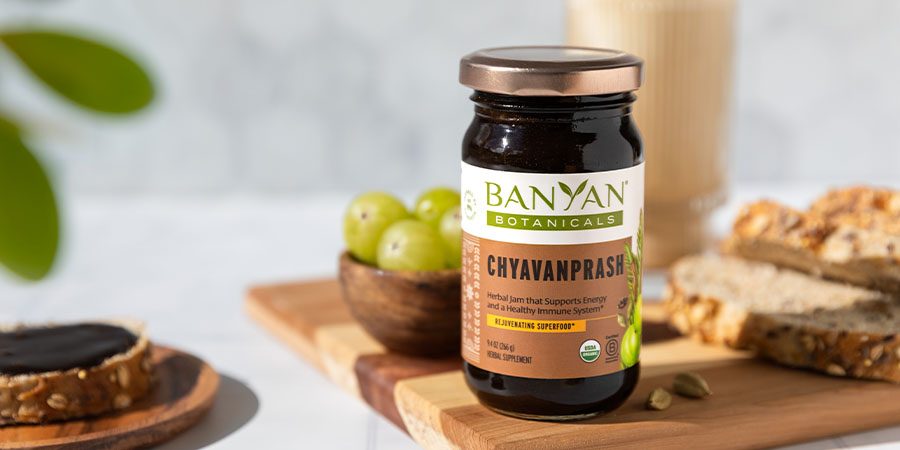
About Banyan’s Chyavanprash
Just like any other herb or health supplement, it’s important to consider the quality and sourcing of your chyavanprash, in order to take as much healing benefit into your body as possible.
As a company, we are committed to sourcing organic, sustainable, and fairly traded herbs. This holds true for the ingredients in our chyavanprash as well, ensuring a potent and high-quality nutritive jam.
When purchasing chyawanprash, there are a number of common questions that may arise. Here is some more information on Banyan’s Chyavanprash sourcing, ingredients, and manufacturing process.
Is It a Traditional Chyavanprash Recipe?
If you compare our ingredient list to other versions of chyavanprash, you may notice some variation.
Several of the herbs found in traditional chyavanprash preparations are very difficult—if not impossible—to obtain sustainably. Banyan’s chyavanprash does not include any ingredients that are endangered or that are difficult to source responsibly.
In fact, the amalaki and other herbal ingredients used in Banyan’s chyavanprash come from privately owned farms where they have been cultivated. The herbs are harvested at optimal times, using environmentally sustainable practices that are sensitive to the long-term health of the plants and their surrounding ecosystems.
How Is Chyavanprash Made?
Our chyavanprash is specially formulated by a manufacturer in India that has produced authentic Ayurvedic jams for over 50 years. The amalaki and other dried powdered herbs are decocted in water and then reduced.
The cane sugar (also called jaggery), ghee, and sesame oil are added to the strained decoction and boiled to form a syrup, and then the fruit pulp is added. Aromatic herbs and honey are added to the mixture after it has cooled so that the honey is never heated or cooked.
What Is the Ratio of Honey and Ghee?
According to Ayurveda, ghee and honey should never be used in equal quantities by weight, so many Ayurvedic experts recommend mixing it in equal weights by volume. Their difference in density ensures that doing so will provide an appropriate ratio between the two.
In Ayurveda, it is commonly understood that the wrong ratio of honey and ghee can create a toxic combination for the body. But when combined appropriately, ghee and honey act as a powerful rejuvenative that can serve as a tonic for all of the tissues in the body.
Banyan’s chyavanprash is made with a carefully considered ratio of honey and ghee to ensure that the combination is healthy, nutritive, and beneficial. The ratio of these ingredients is approximately 7.75% honey and 6.67% ghee.




